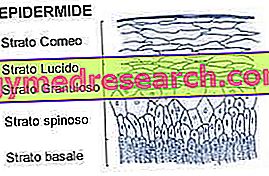Generality
Pemphigus is a bullous dermatosis with an autoimmune etiology, characterized by:
- Presence of specific autoantibodies directed against adhesion molecules between keratinocytes (the antigens are represented by desmogleins), which can be measured in the patient's serum and fixed on the skin of the same.
- Acantholysis (loss of contact between adjacent epithelial cells), resulting in the formation of blisters and erosions in the skin and / or mucous membranes.
The diagnosis of pemphigus is fundamentally clinical (it is a bullous dermatosis), immunopathologic (characterization of autoantibodies) and histological (identifies the overall clinical picture).
The disease is chronic and is potentially fatal if left untreated.
Types of pemphigus
The term "pemphigus" indicates a group of autoimmune skin diseases, united by the development of bullous lesions. These pathologies are often correlated with each other (in general a form presents several subtypes), but clinically they are distinct from the histological and pathophysiological point of view.

The various forms of pemphigus can be classified according to different criteria, but the histopathological site of bubble formation allows a fundamental characterization.
Depending on the location of the bullous lesions in the different layers of the epidermis, ie based on the level in which the acantholysis occurs, we distinguish:
- Pemphigus with low acantholysis (affects the junctions of the deep area of the epidermis, at the level of the basal layer). They belong to this group:
- pemphigus vulgaris
- vegetative pemphigus
- Pemphigus vegetante of Hallopeau
- Neumann vegetative pemphigus
- Pemphigus with high acantholysis (affects the junctions of the surface area of the epidermis, at the level of the granular layer). They belong to this group:
- pemphigus foliaceus
- pemphigus erythematosus
- endemic pemphigus foliaceus
From the clinical point of view, it is possible to recognize some particular forms of presentation of pemphigus:
- Pemphigus with IgA ;
- Drug-induced pemphigus ;
- Paraneoplastic pemphigus ;
- Pemphigus herpetiformis .
The type of desmoglein affected by autoantibodies can also define the form of pemphigus that has occurred. Indicatively, high acantholysis may occur due to the prevalence of anti-Dsg3 antibodies, whereas anti-Dsg1 antibodies occur mainly in low acantholysis .
Pemphigus vulgaris
Photo pemphigus vulgar
Pemphigus vulgaris is the most common clinical form and represents a very serious cutaneous-mucosal disease. The intervention of the autoantibody against desmoglein causes the separation of the cells at the level of the spinous layer (lower portion of the epidermis), with consequent formation of bubbles on mucous membranes and skin, histologically characterized by the presence of acantholytic elements (of separation).
The onset of pemphigus vulgaris is localized and not evident (sneaky): it initially involves the mucous membranes of the oral cavity and the neighboring regions (gums, palate, oropharynx, epiglottis or larynx), where the lesions arise as painful ulcerations. The appearance of the blisters is associated with an often painful symptomatology: the lesions make chewing and swallowing difficult. Often, oral pemphigus is associated with a characteristic odor. The onset of the disease can also affect the anal and genital region.
After a period of a few weeks or months, lesions also gradually appear on the skin, on apparently healthy skin. The bubbles can affect the entire integument, but are concentrated in particular in the groin, armpits, neck, submammary folds, etc. All areas subjected to mechanical pressure can therefore be subject to this type of injury. In this case, the Nikolsky sign (detachment of the epidermis following localized compression of the skin) and the Asboe-Hansen sign (possibility of expanding the bubble by light pressure to the periphery) are positive. At skin level the blisters can be similar to those that appear following second-degree burns.
The bubbles are:
- flaccid: localized inside the epidermis and connected to a cellular adhesion compromised by the altered function of the desmosomes;
- extremely fragile: the bubble's roof consists of a few layers of cells, which can be removed by rubbing a finger near the lesion (Nikolsky's sign);
- of variable dimensions (from one to more centimeters);
- "cold", they are not associated with any perilesional inflammatory process and arise on apparently healthy skin;
- with clear content.
Bullous lesions tend to break and re-epithelize with difficulty. At this stage, the patient is susceptible to infections. The patient feels pain in the lesion (especially based on the location of the blisters), but does not feel itching.
The course of pemphigus vulgaris is subacute or chronic. The evolution of the disease takes place through progressive stages, until, following the diagnosis, action is not taken with the therapy.
Vegetative pemphigus
Vegetable pemphigus photo
The vegetative pemphigus represents the hypertrophic variant of pemphigus vulgaris, of which it can represent evolution (or it may begin as such). Vegetative pemphigus shows a clinical picture similar to that of pemphigus vulgaris, but is associated with a better prognosis. The lesions are initially soft to the touch, red in color and exuding a foul-smelling liquid (wet vegetations). Subsequently, the rupture of intraepidermal bubbles causes the formation of erosive plaques. The most salient feature is that these crusted hypertrophic lesions tend to "vegetate", that is to say to be detected with respect to the skin plane (hyperkeratotic formations). Compared to pemphigus vulgaris, this form is almost constantly located near the large folds (axillae and groin) and is characterized by the presence of often mycotic superinfections.
Vegetative pemphigus is divided into two categories:
- Hallopeau vegetative pemphigus: bubbles † → moist vegetations;
- Neumann vegetative pemphigus: pustular lesions → † 'wet vegetations.
The course is more prolonged but also more benign than the pemphigus vulgaris, as it tends to localize in limited cutaneous regions.
Pemphigus foliaceus
Photo pemphigus Foliaceo
In pemphigus foliaceus, only autoantibodies against type 1 desmoglein are present: for this reason, mucous membranes are not affected by the disease, whereas damage to the skin affects the most superficial layers of the epidermis. Pemphigus foliaceus is characterized by boils, which often originate on the scalp, and then pass to the chest, back and face. Unlike pemphigus vulgaris, these formations are not present orally. The onset is characterized by flaccid bubbles, which, if left untreated, tend to flow together and extend to the whole body. In pemphigus foliaceus lesions appear which, given their superficiality and extreme fragility, tend to break very easily, giving rise to erosive lesions and thin scaly scabs. Most lesions are itchy. When inflammation of the skin surface is associated with the course (with a picture of desquamative erythroderma), Pemphigus foliaceus is associated with painful symptoms. The blisters undergo desquamation and continuous formation, giving the skin a characteristic exfoliative appearance (hence the name "foliaceo"). Often, it is incorrectly diagnosed as dermatitis or eczema.
Pemphigus erythematosus
Also known as Sebearic Pemphigus by Senear-Usher
Pemphigus erythematosus is the localized variant of pemphigus foliaceus. It is characterized by the presence of erythematous-squamous-crusted lesions, mainly located on the face and anterior and posterior mid-thoracic region (seborrheic sites). From a histological point of view, pemphigus erythematosus is similar to foliaceus, with the formation of mosaic IgG deposits in the superficial layers of the epidermis. The disease frequently has clinical aspects similar to those of lupus erythematosus: facial lesions are often distributed as a butterfly and exposure to the sun leads to a worsening of the clinical picture. The course is more benign and slow (it tends to recur).
Pemphigus foliaceus endemic or fogo selvagem
Also known as Brazilian pemphigus
Endemic pemphigus foliaceus affects the indigenous populations of some areas of Brazil. It is hypothesized that a viral infection transmitted by a fly participates in the etiology of the disease. From a clinical point of view, endemic pemphigus is characterized by very painful lesions, associated with a strong burning sensation: the bubbles ulcerate and cause crusted lesions surrounded by inflamed skin. Other clinical, histopathological and immunological aspects are similar to those of pemphigus foliaceus.
Pemphigus with IgA
Pemphigus in IgA represents a particular form of pemphigus, among the least harmful.
The disease is characterized by intraepidermal flaccid blisters, with subcorean deposits of IgA, as well as neutrophils, eosinophils and some acantholytic cells: the histological features are similar to the vulgar form, but the autoantibodies belong to the IgA class. It is characterized by vesic-pustular elements, with a typical archiform arrangement (effect of an acantholysis in the subcorneal area), located on the trunk and on the proximal part of the limbs. The course is quite benign, but tends to recur. The diagnosis is essentially based on the demonstration of the role of IgA, while the therapy involves the administration of dapsone.
Pemphigus in IgA is divided into two subtypes, which differ in their localization and in the different concentration of neutrophils:
- Neutrophilic intradermal IgA dermatosis : the bubbles are deep and the pustules extend to the entire epidermal thickness. Furthermore, this form is characterized by an abundant subcorneal concentration of neutrophils;
- Sneddon-Wilkinson pustular subcornea : it has more superficial lesions and pustules.
Paraneoplastic pemphigus
Paraneoplastic pemphigus is a disease always associated with the presence of a malignant neoplasm. This disorder is a complication of some forms of cancer, sometimes already overt, but in some cases it may precede the diagnosis of the tumor.
It occurs mainly with the following cancerous conditions:
- carcinomas;
- Lymphomas and leukemia;
- Sarcomas.
The cutaneous form can derive from the production, by the tumor, of particular intercellular antibodies (or antigens) and from the general depression of the immune activity.
From a histological point of view, paraneoplastic pemphigus has suprabasal acantholysis, associated with derma-papillary edema (usually not present) and perivascular lymphocytic infiltrate. The pathology indicates a particular clinical entity of pemphigus, different from the clinical and antigenic point of view: the autoimmune process causes the formation of autoantibodies directed both against the desmogleins (Dsg3, Dsg1), and against other various molecules present on the skin and on the membranes mucous membranes (plectin, desmoplachin, p170 etc.?). Paraneoplastic pemphigus is a disease that manifests itself with large areas of dissection of the skin and mucous membranes: it often involves severe ulcers of the mouth and lips, cuts, scars and skin blisters.
Unlike the other forms, it can be associated with an involvement of the lower airways, seriously involving the lungs. Treatment aimed at treating the patient's tumor lesion can improve the conditions associated with paraneoplastic pemphigus, but lung damage is generally irreversible.
Pemphigus herpetiformis
Pemphigus herpetiformis is characterized by the appearance of lesions with intermediate characteristics between vesicles and blisters, with wheals of pruritic urticarial. The distribution of lesions tends to be peripheral, with centrifugal extension. From the histological point of view, it is possible to highlight the passage of eosinophils through the basement membrane (eosinophilic exocytosis) and the absence of acantholysis. The course tends to be benign, although it can potentially evolve into pemphigus vulgaris or foliaceus.



